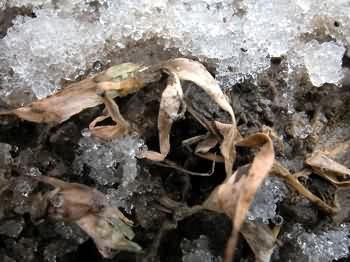Diseases
Microdochium nivale (Fr.) Samuels & I.C. Hallett - Pink snow mold.
Systematic position.
Conidial stage (or anamorph) F. nivale belongs to class Hyphomycetes, order Tuberculariales, family Tuberculariacea, genus Fusarium. Sexual stage (teliomorph) is named as C. graminicola and included into class Ascomycetes, subclass Euascomycetidae, order Hypocreales, family Nectriaceae, genus Calonectria. In 1987 F. nivale was transferred into teliomorph genus Monographella as M. nivalis. Anamorph was named as Microdochium nivale. Pathogen causes the disease of grain crops known as pink snow mold.Synonyms.
Fusarium nivale Ces. ex Berl. & Voglino. Teliomorph Monographella nivalis (Schaffnit) E. Muller = Calonectria graminicola (Berk et Br.) Wollenw. (syn.: C. nivalis, Griphosphaeria nivalis, Micronectriella nivalis)Biological group.
Hemybiotrophic wheat pathogen.Morphology and biology.
Disease is visible in early spring when snow thaws. Water soaked spots with white mat mycelium on leaves begin to appear. Because of abundant development of patches, leaves stick together and fade. Under conditions favorable for the disease development the fungus may kill crowns, leaf sheaths, and roots, and plant die-off is observed. During the vegetation season, the conidial infection is forming on leaf sheaths and blades near soil level. In addition to the conidial stage, the fungus develops a sexual stage represented by surface perithecia situated in basal leaf sheaths. Ascospores infect upper leaves in spring and summer in cool wet weather. Pathogen maintained in soil on infected plant residues, and can start autumn infection of winter wheat. Fungus conidia are fusiform, sickle-shaped, hyaline (pink in mass), 14-25 x 3-4 .m. Perithecia are conic to globular, brick-red. Asci are clavate, thin-walled, 50-70 x 8-10 .m, with 6 to 8 ascospores in each. Mature ascospores are ellipsoid, straight or curved, hyaline, with 1 to 3 septa.Distribution.
Pink snow mold occurs on wheat in central Europe, Scandinavia, Canada and the USA. In Russia it is widely distributed in zones where winter cereals are grown. Pink snow mold is especially important on wheat in the northeastern and central regions of Russia and in Byelorussia. Since the end of the 1980.s the disease has become economically important in the North-Caucasian Region, where it infects upper leaves during the vegetation period.Ecology.
Mycelium development begins on winter cereals in autumn, and is most apparent in early spring after snow thaws. The snow mold pathogens are the most aggressive at low temperatures (5.C), and widely distributed in areas with a cold Spring. Low winter temperature limits fungus development, but viability of mycelium and conidia is maintained even at .33 ╓C. Under natural conditions such temperatures may only be encountered during winters without snow cover.Economic significance.
The pathogen occurs on species of the genera Triticum, Secale, Dactylis, Agrostis, Poa, Alopecurus and other Poaceae. Snowy winters, low temperatures, humid soil conditions, a long snow-thawing period, and soil acidity promote the development of the disease. In the northwestern and central regions of Russia epidemics are observed three years out of ten with disease development from 40 to 50%, and plant destruction from 15 to 20%. On some fields wheat crops may be completely destroyed. Protective measures: combination of land treatment and crop rotation.Reference citations:
Anon. 2001. Prediction of diseases and pests appearance and distribution on agricultural crops in 2001. Nishnii Novgorod: Regional Plant Protection Station. 8-9 pp. (In Russian)Ishkova T.I., Berestetskaya L.I., Gasich E.V., Vlasov D.Y. 2001. Methodical instruction for diagnostics of major cereal fungal diseases. St. Petersburg: VIZR. 22-24 pp. (In Russian)
Sanin S.S., Nasarova L.N., Sokolova E.A., Ibragimov T.S. 1999. Health of cereals field. Zashchita i karantin rastenii 2: 28-31. (In Russian)
Sergeenko V.I. 1984. Biological characteristics of agent of rye snow mold (Fusarium nivale/Fr./Ces.) and creation of primary resistant materials. PhD Thesis. Minsk, Samokhvalovichi: Byelorussian Institute of Potato and Fruit-Vegetable Crops. 16 pp. (In Russian)
Shipilova N.P. 2003. Systematic of fungi of the genus Fusarium. In: Dyakov Yu., Sergeeva Yu., editors. News in systematics and nomenclature of fungi. Moscow: Nauka. 192-219 pp. (In Russian)
Zakharenko V.A., Kuzmichev A.A., Plotnikov V.F., et al. 2000. Extent and trends of species composition and population structure changes, areas of harmful and useful organisms complexes, and forecast of dangerous phytosanitary situations in Russian regions. St. Petersburg: RASKhN. 1-100 pp. (In Russian)
© Gultyaeva E.I.


